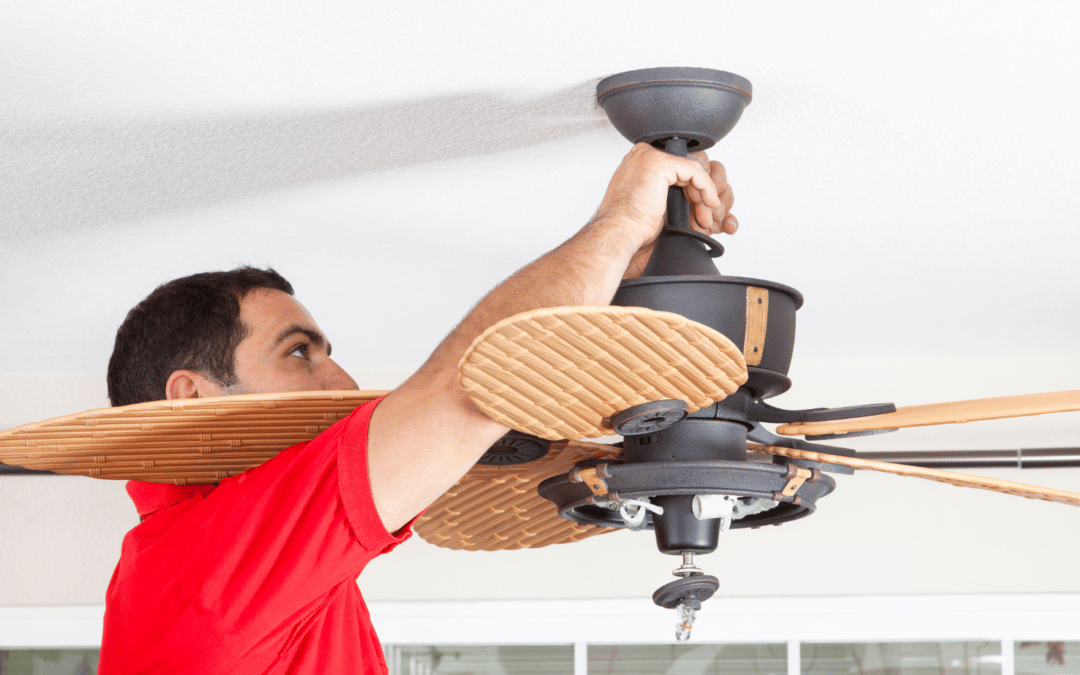Ceiling fans are a great way to keep your home cooler in summer and warmer in winter, saving money on electricity and increasing your family’s comfort level. But have you ever thought about why?
The answer lies in the natural movement of air. Put simply, warm air rises, and cold air sinks. A ceiling fan redistributes the air more evenly and changes the way it moves around in your room. There are optimal settings on a ceiling fan for all four seasons.
Winter: Clockwise for heating
In the winter, ceiling fans should rotate clockwise at a low speed. This creates an updraft, pulling the cool air up and pushing the warm air, which naturally rises to the ceiling, down along the walls and back into the living space. This helps redistribute the warm air more evenly throughout the room.
By circulating the warm air this way, you can potentially lower heating costs by giving your heating system some extra help as it works to maintain a comfortable temperature in the house. Experts estimate you can save up to 15% on your heating bills by utilizing ceiling fans set on the winter direction.
Check it out!
Check the direction by standing under the fan and watching the blades spin. They should be rotating clockwise (from left to right). Another way to check is to stand under the fan while it’s on high speed and change the direction. Whichever way you feel the least amount of cool air is the correct direction. You can also blow some soap bubbles and watch where the air flow takes them – to the ceiling or the floor?
Spring: The transitional season
During the still-cold first half of spring, continue to reduce heating costs by using the clockwise setting to heat your rooms more uniformly. As the days warm up, hold off on running your air conditioning by switching the ceiling fan direction to counterclockwise and running the fan on high to take advantage of the wind chill effect (see below).
Summer: Counterclockwise for air conditioning
In the summer, the ceiling fan direction should be counterclockwise to help create a downdraft, which you will experience as a direct, cooling breeze. This action moves the cold air down to the bottom of the room quicker than the natural sinking of that air.
Ceiling fans cause what’s known as the “wind chill effect.” When the air hits your skin, it speeds up evaporation of moisture on your skin, which makes you feel cooler. The use of a ceiling fan allows you to turn up the thermostat approximately 4 degrees when in use. For example, if your thermostat is set at 80 degrees, the use of a ceiling fan will make it feel like 76 degrees in the room. Experts estimate you could save about 40% on your energy bill in the summer by using ceiling fans in conjunction with air conditioning.
Check it out!
Stand under the ceiling fan and watch the blades spin. They should be rotating counterclockwise (from right to left). Another way to check is to stand under the fan while it’s on high speed and change the direction. Whichever way you feel the most amount of cool air is the correct direction. You can also blow some soap bubbles and watch where the air flow takes them – to the ceiling or the floor?
Autumn: The transitional season
Save money by turning off your air conditioning when the days get cooler and rely on the summer counterclockwise setting on your fans to produce a 4- to 8-degree reduction in room temperatures.
How do I change the ceiling fan direction?
Depending on your fan model, there are a few ways to change its direction.
- Reversing fan switch. Fans with pull chains typically have a fan switch that changes its direction. After turning off the fan and letting it come to a complete stop, check the fan body for this switch. It may be under the glass globe encasing the lights.
- Handheld fan remotes. Turn off the fan and let it come to a complete stop. Press and hold the fan button on the remote control. The light on the remote control will blink when it’s succeeded in changing the fan direction.
- Smart fan technology. Turn off the fan and let it come to a complete stop. Change the direction using an app or a voice command.
When should I make the switch?
A good reminder to change your ceiling fan direction is when the time changes. When we “spring forward,” set your fans to spin in a counterclockwise direction. When we “fall back,” change your fans to rotate in a clockwise direction.
Ceiling fan switch, push button control on the fan remote or voice commands with smart fans.
For related content, check out our blogs How To Install A Ceiling Fan Light Kit, 11 Best Ways To Save On Your Electric Bill During The Summer and 9 Easy Ways To Save On Your Electric Bill This Winter.
How Can We Help?
At Shockley Electric, we address important home safety issues such as power surges, faulty electrical wiring and potential fire hazards when we do electrical preventive maintenance in homes or commercial buildings. We are licensed, trained, and skilled in safety-proofing your home, and we are committed to the safety and well-being of our customers.

